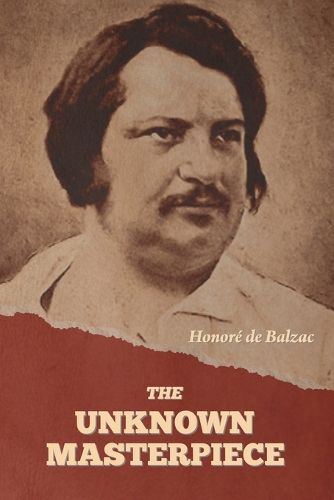Readings Newsletter
Become a Readings Member to make your shopping experience even easier.
Sign in or sign up for free!
You’re not far away from qualifying for FREE standard shipping within Australia
You’ve qualified for FREE standard shipping within Australia
The cart is loading…






This title is printed to order. This book may have been self-published. If so, we cannot guarantee the quality of the content. In the main most books will have gone through the editing process however some may not. We therefore suggest that you be aware of this before ordering this book. If in doubt check either the author or publisher’s details as we are unable to accept any returns unless they are faulty. Please contact us if you have any questions.
"Le Chef-d'oeuvre inconnu" (English: "The Unknown Masterpiece") is a short story by Honore de Balzac. It was first published in the newspaper L'Artiste with the title "Maitre Frenhofer" (English: "Master Frenhofer") in August 1831. It appeared again later in the same year under the title "Catherine Lescault, conte fantastique". It was published in Balzac's Etudes philosophiques in 1837 and was integrated into La Comedie humaine in 1846. The work is separated into two chapters: "Gillette" and "Catherine Lescault".
"Le Chef-d'oeuvre inconnu" is a reflection on art, and has had an important influence on modernist artists.
Unlike most other stories in La Comedie humaine, this is set in the 17th century, in the year 1612. Of the three artists depicted in this story, Poussin and Porbus were real artists of the 17th century. Frenhofer is a purely fictional character. In the case of Porbus, Balzac used the gallicized version of the surname of Frans Pourbus.
Paul Cezanne strongly identified with Frenhofer, once saying "Frenhofer, c'est moi" (I am Frenhofer). Critic Jon Kear argues that Cezanne's own attempts to paint the nude were heavily influenced by Balzac's portrayal of Frenhofer's work.
In 1927, Ambroise Vollard asked Picasso to illustrate "Le Chef-d'oeuvre inconnu". Picasso was fascinated by the text and identified with Frenhofer so much that he moved to the rue des Grands-Augustins in Paris where Balzac located Porbus' studio. There he painted his own masterpiece, Guernica. Picasso lived here during World War II.
Sidney Peterson's 1949 avant-garde film Mr Frenhofer and the Minotaur was based on the link between the short story and the work of Picasso. It draws on Picasso's Minotauromachy, bringing Picasso's work to life with the characters of Gillette, Poussin and Porbus participating.
"Le Chef-d'oeuvre inconnu" inspired the film La Belle Noiseuse by Jacques Rivette (1991). (wikipedia.org)
$9.00 standard shipping within Australia
FREE standard shipping within Australia for orders over $100.00
Express & International shipping calculated at checkout
This title is printed to order. This book may have been self-published. If so, we cannot guarantee the quality of the content. In the main most books will have gone through the editing process however some may not. We therefore suggest that you be aware of this before ordering this book. If in doubt check either the author or publisher’s details as we are unable to accept any returns unless they are faulty. Please contact us if you have any questions.
"Le Chef-d'oeuvre inconnu" (English: "The Unknown Masterpiece") is a short story by Honore de Balzac. It was first published in the newspaper L'Artiste with the title "Maitre Frenhofer" (English: "Master Frenhofer") in August 1831. It appeared again later in the same year under the title "Catherine Lescault, conte fantastique". It was published in Balzac's Etudes philosophiques in 1837 and was integrated into La Comedie humaine in 1846. The work is separated into two chapters: "Gillette" and "Catherine Lescault".
"Le Chef-d'oeuvre inconnu" is a reflection on art, and has had an important influence on modernist artists.
Unlike most other stories in La Comedie humaine, this is set in the 17th century, in the year 1612. Of the three artists depicted in this story, Poussin and Porbus were real artists of the 17th century. Frenhofer is a purely fictional character. In the case of Porbus, Balzac used the gallicized version of the surname of Frans Pourbus.
Paul Cezanne strongly identified with Frenhofer, once saying "Frenhofer, c'est moi" (I am Frenhofer). Critic Jon Kear argues that Cezanne's own attempts to paint the nude were heavily influenced by Balzac's portrayal of Frenhofer's work.
In 1927, Ambroise Vollard asked Picasso to illustrate "Le Chef-d'oeuvre inconnu". Picasso was fascinated by the text and identified with Frenhofer so much that he moved to the rue des Grands-Augustins in Paris where Balzac located Porbus' studio. There he painted his own masterpiece, Guernica. Picasso lived here during World War II.
Sidney Peterson's 1949 avant-garde film Mr Frenhofer and the Minotaur was based on the link between the short story and the work of Picasso. It draws on Picasso's Minotauromachy, bringing Picasso's work to life with the characters of Gillette, Poussin and Porbus participating.
"Le Chef-d'oeuvre inconnu" inspired the film La Belle Noiseuse by Jacques Rivette (1991). (wikipedia.org)